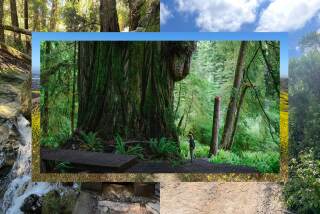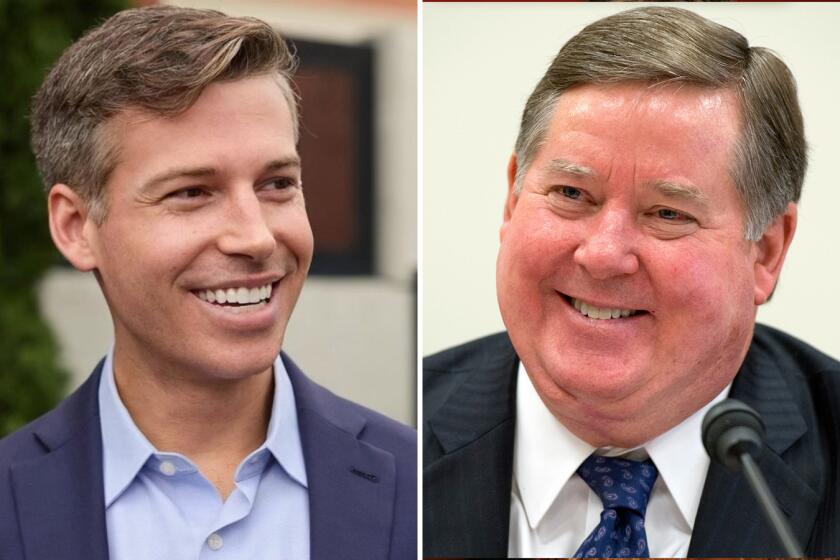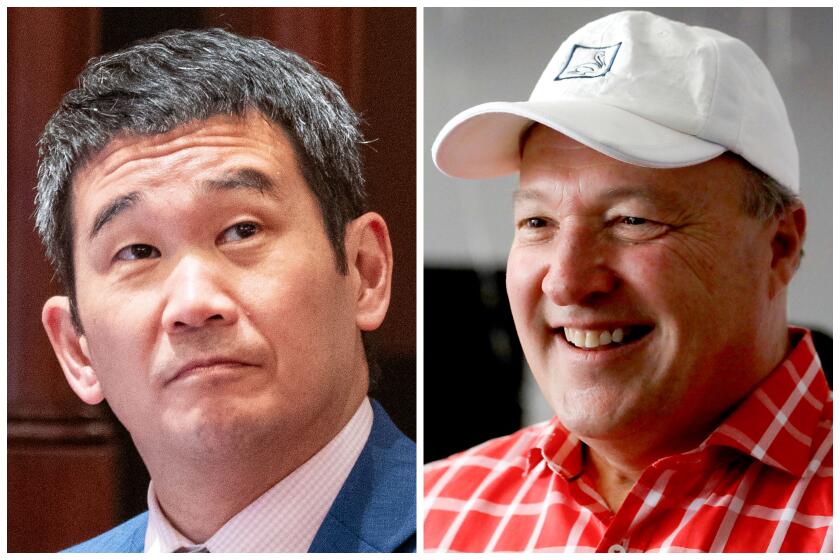Newsletter: Essential California: For whom the mission bell tolls
Good morning, and welcome to the Essential California newsletter. It’s Friday, June 21, and I’m writing from Los Angeles.
The dangling silhouette of the mission bell has become a defining element of California iconography.
You’ve seen them in history books, countless souvenirs and on highway markers commemorating the “Historic El Camino Real” across the state.
To some, those mission bells conjure the romance of California’s Spanish past — a paternal Mission pastoral punctuated by elegant archways, vine-covered ruins and ornate pageantry.
To others, like tribal leader Valentin Lopez, those bells represent unimaginable suffering and destruction.
“ ‘We conquered you, we controlled you, we destroyed you’ — that’s what those symbols mean to us,” Lopez, who serves as chairman of the Amah Mutsun Tribal Band, explained. The Amah Mutsun are descendants of the indigenous people who were taken to Missions San Juan Bautista and Santa Cruz near California’s Central Coast.
On Friday morning, a mission bell that has long hung near the Hahn Student Services Building at UC Santa Cruz will be removed. By the time you’re reading this, it might have already happened. But the process was by no means simple or quick.
Lopez has been campaigning for the removal of mission bells for years, and spent the past year in discussion with campus leaders over the removal of this particular bell.
“We’ve been trying to get the mission bells to come down for a while. The bell coming down at UC Santa Cruz is the first bell that we are aware of to come down,” said Lopez, who added that he had been inspired, in part, by the ongoing removal of Confederate monuments in the South.
The Santa Cruz bell removal comes during a period of larger reckoning around California’s blood-soaked treatment of its native people. On Tuesday, Gov. Gavin Newsom took the rare step of issuing an executive order apologizing on behalf of the citizens of California for a history of “violence, maltreatment and neglect” against Native Americans.
“It’s called a genocide. That’s what it was. A genocide,” Newsom said Tuesday at a ceremony with more than 100 tribal leaders. “[There’s] no other way to describe it, and that’s the way it needs to be described in the history books.”
The problem, of course, is that the history books didn’t look anything like that for the generations of Californians who came of age making popsicle-stick-and-sugar-cube mission models in the fourth grade. And the rose-colored repackaging of our brutal mission history didn’t emerge on accident.
Boosters, real-estate developers and automobile associations alike used a romanticized Spanish past to sell modern Southern California into being. But much of what they were shilling was fiction.
For instance, the entire idea of California having a singular El Camino Real that ran like a central artery through the state — connecting the 21 missions and acting as a path for the Franciscan friars — is a 20th century reinvention. Yes, there were missions and ways to get from one to the next, but the nostalgic notion of a single camino is “a fiction created in the 20th century to promote automobile tourism up and down the coast of California,” as UC Riverside history professor Steven Hackel explained to KCET a few years ago.
The roadside mission bell markers you’ve seen on the highway emerged through the work of a local activist, backed by the Auto Club. The first commemorative mission bell was erected along the route in 1906. By 1915, there were 400 mission bell guideposts between San Diego and Ventura and they “began to have a cultural impact early in their life span,” according to historian Phoebe Kropp’s “California Vieja.”
[See also: “How El Camino Real, California’s ‘Royal Road,’ Was Invented” by Nathan Masters]
California’s car culture and the reinvented history of the El Camino Real rose in tandem, as the state drew early automobile tourists and fed them a delectable revisionist history, conveniently divided into easy day trips.
Caltrans embarked on a project to restore the original highway marker bells in 1997 and received two federal grants totaling nearly $2 million to complete the project. There are about 585 mission bell markers, placed about one to two miles apart along the roadside on State Routes 101, 82, 37, 121 and 12, according to Caltrans’ website.
“To see those mission bells every mile on the freeway from San Diego up north to San Francisco — that’s just a constant, in-your-face reminder of our destruction and the domination of our culture,” Lopez said. “That’s what those bells represent.”
And now, here’s what’s happening across California:
TOP STORIES
Amid the college admissions scandal, the University of California released a sweeping list of recommendations aimed at better policing of fraud and conflicts of interest in admitting students. Los Angeles Times
Sacramento is mourning the death of slain police officer Tara O’Sullivan, a 26-year-old gunned down in the line of duty Wednesday. Hers was the first line-of-duty death in the department in 20 years. Sacramento Bee
Get the Essential California newsletter »
L.A. STORIES
For Santa Anita’s low-paid backstretch workers, horse deaths bring pain and fears about the future. Los Angeles Times
The heated battle over automation and jobs at the Port of L.A. is headed to the City Council. Los Angeles Times
Have you seen that viral map that overlays the New York boroughs over a map of Los Angeles? Here’s what it gets wrong. L.A. Taco
A micro-guide to three very different, interesting coffee bars that are making L.A.’s Chinatown a destination for coffee drinkers. Los Angeles Times
“Nearly all” publicly owned properties in the city are now mapped on the L.A. city controller’s website. Los Angeles Daily News
Your support helps us deliver the news that matters most. Subscribe to the Los Angeles Times.
POLITICS AND GOVERNMENT
California’s contentious vaccine bill has passed an Assembly committee. Hundreds of parents spoke in opposition to tightening California’s school immunization requirements during the five-hour hearing. Los Angeles Times
Hollywood’s top gay donors have mixed feelings on Mayor Pete Buttigieg. Politico
L.A. City Councilman Jose Huizar won’t have to answer questions in a harassment lawsuit filed by an ex-staffer until the FBI’s criminal investigation involving him is resolved. Los Angeles Times
CRIME AND COURTS
A Shasta County public defender attacked his family, including two children, with an “ax.” Redding Record Searchlight
After a judicial #MeToo scandal, the California-based U.S. 9th Circuit Court of Appeals conducted extensive outreach and made a number of changes aimed at improving its workplace environment. (Alex Kozinski, a longtime 9th Circuit judge, retired in Dec. 2017, after multiple women accused the high-profile judge of sexual harassment.) Bloomberg Law
THE ENVIRONMENT
A 13-year-old girl was bitten by sea lion in a “very rare” attack at Pismo Beach. San Luis Obispo Tribune
CALIFORNIA CULTURE
A Joshua Tree sonic artist aims to capture the “silence” of the California desert. Desert Sun
The nation’s three most expensive counties for renting a home are all in the Bay Area. Mercury News
Fresno-based tech hub Bitwise has raised $27 million in investment, one of the largest levels of financing for a Central Valley-based tech company “in recent memory.” They now plan to expand to Bakersfield. Fresno Bee
See also: Bitwise’s planned expansion into Bakersfield is seen as taking the city to “the next level.” Bakersfield Californian
Today in late-stage capitalism: Have you always dreamed of floating on a pool raft shaped like a giant Taco Bell sauce packet, sleeping under a Taco Bell mural and waking up to a special Taco Bell breakfast waiting outside your door? Well, dream no more, because Taco Bell’s pop-up Palm Springs hotel will soon be taking reservations. Here’s a peek inside. Desert Sun
CALIFORNIA ALMANAC
Los Angeles: partly sunny, 70. San Diego: cloudy, 68. San Francisco: sunny, 66. San Jose: sunny, 80. Sacramento: sunny, 90. More weather is here.
AND FINALLY
Everyone wants to be Cary Grant. Even I want to be Cary Grant
— Cary Grant
If you have a memory or story about the Golden State, share it with us. (Please keep your story to 100 words.)
Please let us know what we can do to make this newsletter more useful to you. Send comments, complaints, ideas and unrelated book recommendations to Julia Wick. Follow her on Twitter @Sherlyholmes.
More to Read
Sign up for Essential California
The most important California stories and recommendations in your inbox every morning.
You may occasionally receive promotional content from the Los Angeles Times.











